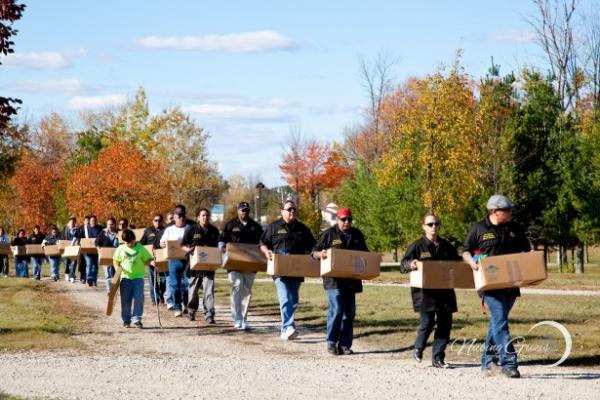By Frances Madeson for Indian Country today Media
The topic sounded dry as bones, but the discussion was anything but.
Seventy people gathered at the Indian Arts Research Center at the School for Advanced Research in Santa Fe to hear experts tell of their personal experiences with the Native American Graves Protection and Repatriation Act, or as it is more commonly known—NAGPRA.
Moderator Bruce Bernstein, of the Coe Foundation, framed the discussion in terms of the tangible and intangible consequences of NAGPRA. The tangible being the return of the “product” (in the bureaucratic mindset) and the intangible being the emotional and intellectual journey precipitated by its return. As Bernstein put it: “The return begins a deeper sense of what it is to be reunited, to be stewards not owners.”
Panelists Regis Pecos, a long-time tribal leader from Cochiti Pueblo; Brian Vallo, of Acoma Pueblo and director of IARC; and Joe Watkins, an archaeological, cultural and education consultant with the National Park Service from the Choctaw Nation of Oklahoma, described with raw candor the mixed emotions prompted by the 26-year-old law—joy when sacred objects of Indian patrimony considered forever lost find their way home, and heartache at the return of human remains in a very imperfect process. A process according to Pecos that: “has unveiled something horrible about the history of this country” and in which Indians are “forced to violate our own covenants to conform with Western jurisprudence, forced to engage in sacrilege.”
 Moderator Bruce Bernstein with panelists Regis Pecos, Joe Watkins and Brian Vallo. They gathered with some 70 attendees to discuss NAGPRA. (Courtesy Jennifer Day/School for Advanced Research)
Moderator Bruce Bernstein with panelists Regis Pecos, Joe Watkins and Brian Vallo. They gathered with some 70 attendees to discuss NAGPRA. (Courtesy Jennifer Day/School for Advanced Research)
In 1979, anthropologist Joe Watkins joined with other experts in a series of regional consultations across the United States, which resulted in a report on the return of cultural objects, the protection of cemeteries and the return of human remains. These were the roots of the legislative struggle that eventually led, 11 years later, to the passage of NAGPRA. In Watkins’ view, its passage in 1990 was a step forward insofar as it “acknowledged the land”—the idea that Indian peoples and sacred objects are attached (legally) to their lands. But it also created an “archaeology without people,” wherein the very people who had to live with the new policy were disregarded. Overnight, tribes were confronted with “boxes and boxes of materials they didn’t know what to do with.” And even more painfully, some tribes were thrust into a vexing and sometimes agonizing religious conundrum—“they had no ceremonies for reburial.”
Vallo described the thorny morass of “burden of proof.” Tribes would receive numerous inventories (one Vallo said contained 300,000 objects), and would have to provide information and verification. “It wasn’t enough to say ‘yes, this is ours,’” he explained. “Often it became contentious between pueblos.” How could it not when boxes were labeled (mislabeled) Acoma/Zuni/Laguna? According to Vallo, the process “created this tension for some objects we’re still negotiating for.” And while the tribes fight it out, the treasures remain in the collections of the institutions.
At Acoma, 2,900 human remains have been reinterred in what Vallo described as a “slow and expensive process.” The financial cost falls to the tribes, but in some ways the monetary expense, though burdensome, pales in comparison to the spiritual conflicts that have arisen in communities where people have had genuine disagreements about how to proceed. “Journeys [in the afterlife] were disrupted,” Pecos explained. “In that disruption they will never be able to fulfill their destiny.” The tribes had to grapple with mysteries and taboos which led them to pose questions for which there are no certain answers…‘Is there a way to reconnect them to their journey?’A whole new word was invented in their Native language of Keres, which became a kind of mantra—a portmanteau of ‘fear and sympathy.’”
“You do the best you can because you are compromised,” Pecos said.
Bernstein had also inquired about the positive effects of NAGPRA and the panel described several important gains. “There is now a cohort of American Indian people who are trained to take over the management and protection of the sacred objects,” Watkins said. “And they have a hybrid approach: they recognize spirit and energy and are harnessing it to help the community flourish and prosper.” According to Pecos, NAGPRA “opens the door for future laws for the protection of Native languages and the return of aboriginal lands.” From Vallo’s perspective, the main advance has been in the area of consultation. Federal laws have influenced states to mandate consultation with tribes, and the idea has also caught on in the private sector. “Tribes have built capacity and there is a much stronger voice of Native America on issues that effect policy,” Vallo explained, “which is setting the stage for a conversation about a new law.”
A new law could help make international repatriations easier. A new law could obtain to private collectors including universities (NAGPRA does not) so that human remains, funerary objects, sacred objects, objects of Indian patrimony currently held in private hands must also be returned. In considering the new law, Pecos poses these questions:
“What are we doing differently from what we used to criticize museums for? Have we internalized our own oppression? What can we do better? What do we love most about what we come from? What threatens what we love? What do we want future generations to inherit from us? What core value would you share that has led you to do the things you’ve done in your life? And who gifted you that?”










